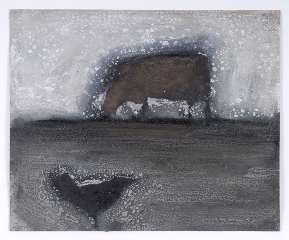Art in America Review
February, 2007
Colin Cochran at Joyce Goldstein by Edward M. Gomez
 Colin Cochran is an American artist who grew up on Cape Cod and is based in New York and Santa Fe; for many years, he has made mixed- medium paintings that are characterized by rich surface textures and an experimental use of pigments. Cochran’s signature style combines flatly painted passages of color (as opposed to fully modeled
Colin Cochran is an American artist who grew up on Cape Cod and is based in New York and Santa Fe; for many years, he has made mixed- medium paintings that are characterized by rich surface textures and an experimental use of pigments. Cochran’s signature style combines flatly painted passages of color (as opposed to fully modeled
details) and watery brushstrokes in basic object-and-ground images that gently abstract their subjects. Among them are plain, boxy houses, animals–especially crows, hens, sheep and fish–and cacti, reduced to simple, recognizable shapes. Cochran likes to evoke the varied textures that appear in nature, even as he cooks up new visual and physical surface effects of his own. He often starts with sheets of rough sandpaper, which he covers with gesso before brushing on coats of oil glaze, then colored, water-based paints. Those watery washes can never be fully absorbed by the support or by intermediary oily layers, but in time, they do dry. Sometimes he rubs raw pigment or charcoal scrapings into the surfaces while they are still wet, so that later, when dry, they are crusty but nonetheless lustrous. (Occasionally he uses an electric hair dryer to speed up the drying process, which creates cracks in the surface.)
Cochran also works on wood, metal and ceramic tile. Normally, his paintings are small and intimate-feeling. It may not be an accident that, in spirit and technique, they recall the strongly massed, broodingly romantic canvases of Albert Pinkham Ryder, who also painted faster-drying atop slower-drying layers so that an underlying application would pull an overlying one apart. In new paintings like Speckled Sheep (2006), made with oil glaze, gouache and dry pigment on gessoed board, or Elephant Eye (made with the same mediums on paper, 2006) the bubbles and puddles of pigment have dried in transparent splotches of color that give the works a dreamy, melancholy air.
Birdhouse (2006), a postcard-size, mixed-medium painting on sandpaper, also reflects this mood. In it, a plain black hut appears directly in the foreground but also at a mysterious remove, as if seen through water, submerged at the bottom of a pool. The image emerges through a foam of turquoise, green and black. Recalling Susan Rothenberg’s emblematic horses, some of Cochran’s subjects are at once apparitions and solid entities, like the bird and beast in Brown Cow (2006), also on gessoed sandpaper. Cochran’s art is that of an inquisitive, restless experimenter who is in considerable command — and, unabashedly, in awe — of the expressive power of paint.